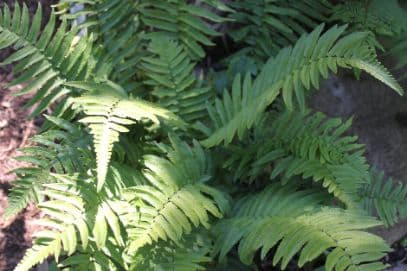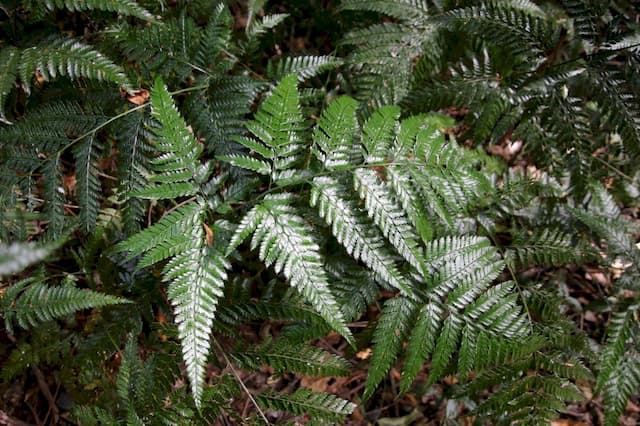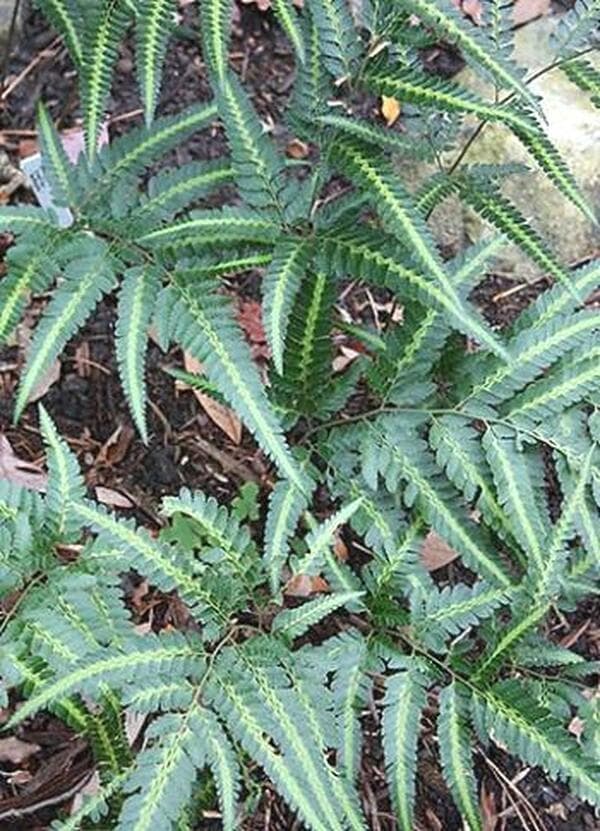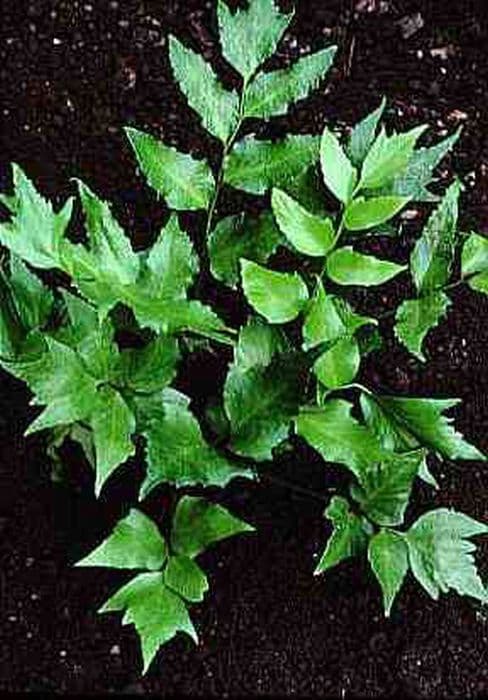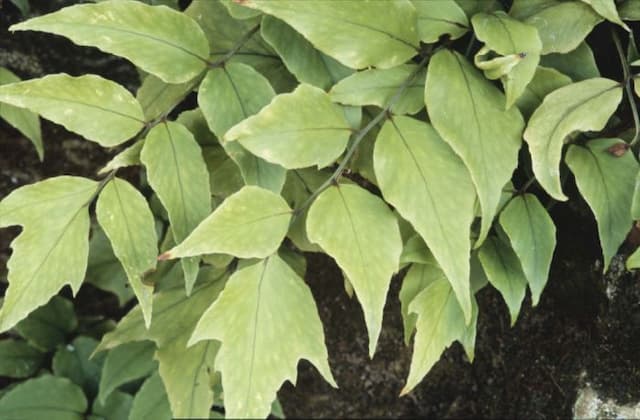Scaly male fern 'Polydactyla Mapplebeck' Dryopteris affinis (Polydactyla Group) 'Polydactyla Mapplebeck'

ABOUT
'Polydactyla Mapplebeck' is a robust semi-evergreen perennial to 1.2m tall, forming a rosette of arching fronds, boldly forked and crested at the apex, the pinnae also crested
About this plant
 Names
NamesFamily
Dryopteridaceae
Synonyms
Golden Shield Fern, Scaly Male Fern
Common names
Dryopteris affinis subsp. cambrensis, Dryopteris borreri, Dryopteris cambrensis, Dryopteris paleacea, Dryopteris pseudo-filix-mas, Lastrea borreri, Lastrea cambrensis, Nephrodium borreri, Nephrodium filix-mas var. paleaceum, Nephrodium pseudomas.
 Characteristics
CharacteristicsLife cycle
Perennials
Foliage type
Evergreen
Color of leaves
Green
Height
3 feet (0.91 meters)
Spread
3 feet (0.91 meters)
Plant type
Fern
Hardiness zones
5
Native area
Europe
Benefits
 General Benefits
General Benefits- Ornamental Value: The Dryopteris affinis 'Polydactyla Mapplebeck', commonly known as the Scaly Male Fern, adds aesthetic appeal to gardens and landscapes with its attractive, arching fronds and intricate leaf patterns.
- Habitat Support: It can provide a suitable habitat or microclimate for various fauna, especially insects and other invertebrates.
- Erosion Control: Its root system can help stabilize soil and prevent erosion, especially in shaded or woodland garden settings.
- Low Maintenance: Once established, the Scaly Male Fern requires minimal care, making it a convenient choice for gardeners with limited time.
- Shade Tolerance: It thrives in shaded areas where other plants may struggle, helping to cover bare spots under trees or in other low-light areas of the garden.
- Seasonal Interest: The plant provides year-round greenery in milder climates, contributing to the seasonal interest of the garden.
- Wildlife Friendly: The Scaly Male Fern can provide cover for small animals, birds, and beneficial insects, enhancing biodiversity.
- Drought Resistance: Once mature, it can withstand periods of drought, reducing the need for frequent watering.
 Medical Properties
Medical PropertiesThis plant is not used for medical purposes.
 Air-purifying Qualities
Air-purifying QualitiesThis plant is not specifically known for air purifying qualities.
 Other Uses
Other Uses- Landscape photography: The intricate fronds of the Dryopteris affinis serve as detailed subjects or natural backdrops for outdoor photography endeavors.
- Floral arrangements: Adding a touch of greenery with its lush fronds can enhance the visual appeal of bouquets and indoor floral arrangements.
- Education and research: This plant is ideal for botany studies or classroom demonstrations because of its easily identifiable features typical of ferns.
- Art inspiration: The unique patterns of the fern can inspire artists for print designs, paintings, or even sculptures.
- Nature crafts: Dried fronds can be utilized in crafting bookmarks, herbarium sheets, and other decorative items that require a natural touch.
- Costume design: The leaves can be used to create forest-themed costumes or for set decoration in theatrical productions to mimic woodland scenes.
- Shade garden accent: Owing to its tolerance for shade, the fern can be used to fill spaces in shade gardens, providing texture and fullness.
- Bonsai landscapes: Small specimens can sometimes be incorporated into bonsai garden scenes to simulate trees at a smaller scale.
- Pond-side planting: Its affinity for moist soil makes it a suitable choice for planting near ponds or water features to create a naturalized setting.
- Erosion control: On slopes or areas with loose soil, the fern can help stabilize soil and prevent erosion due to its spreading habit.
Interesting Facts
 Feng Shui
Feng ShuiThe Golden Male Fern is not used in Feng Shui practice.
 Zodiac Sign Compitability
Zodiac Sign CompitabilityThe Golden Male Fern is not used in astrology practice.
 Plant Symbolism
Plant Symbolism- Resilience: Dryopteris affinis, commonly known as the Golden Male Fern, is a robust and hardy plant, symbolizing the ability to thrive in varied and challenging conditions.
- Shelter: With its lush foliage, the Golden Male Fern provides shelter and protection to smaller plants and insects, symbolizing a haven or sanctuary.
- Secretiveness: Ferns often grow in shaded, hidden places in the forest and are associated with mystery and the concealment of knowledge or secrets.
- Endurance: The fern's ability to survive in the wild for long periods demonstrates its symbolization of endurance and the capacity to withstand time and adversity.
- Eternal Youth: The Golden Male Fern's evergreen nature allows it to stay vibrant throughout the seasons, symbolizing vitality and the renewal of life.
 Water
WaterThe Scaly Male Fern should be watered thoroughly, allowing the top inch of soil to dry out before watering again. A good rule of thumb is watering approximately once every week to ten days, depending on environmental conditions such as temperature and humidity. Provide the plant with about 16 ounces of water each time, ensuring that the water reaches deep into the root zone without leaving the plant in standing water, which can lead to root rot. During the winter months, reduce the frequency of watering since the plant will be in a dormant state.
 Light
LightScaly Male Fern thrives in dappled shade, ideally benefiting from filtered sunlight rather than direct exposure which can scorch its fronds. The best spot for this fern is in a north-facing or east-facing room where it can receive gentle morning light or indirect light throughout the day. Avoid placing it in the full afternoon sun to prevent damage to its delicate leaves.
 Temperature
TemperatureThe Scaly Male Fern prefers a moderate temperature range and can survive in temperatures as low as 50 degrees Fahrenheit and as high as 75 degrees Fahrenheit. The ideal temperature for this plant is between 60 and 70 degrees Fahrenheit. It is not tolerant of extreme cold, so it's important to keep it away from drafty windows and doors during the winter months.
 Pruning
PruningPruning the Scaly Male Fern is primarily to remove any brown or damaged fronds, which should be cut back to the base to maintain the plant's appearance and health. This task is best done in the spring to make way for new growth. Pruning is not frequently required but can be performed as needed when you notice dead or unsightly foliage.
 Cleaning
CleaningAs needed
 Soil
SoilThe Golden Male Fern needs a well-draining soil mix with a pH range of 5.5 to 6.5. A mixture of loam, peat, and sand is ideal, providing moisture retention and aeration. Incorporating organic matter like leaf mold can also benefit the plant's growth.
 Repotting
RepottingThe Golden Male Fern should be repotted every 2 to 3 years. It's best to repot when the plant has outgrown its current container or when the soil has become compacted, which can hinder the fern's root growth and health.
 Humidity & Misting
Humidity & MistingGolden Male Fern thrives in high humidity conditions. The ideal humidity level for this fern is around 60 to 80%. Maintaining such humidity levels can be crucial for the fern's lush, green fronds and overall health.
 Suitable locations
Suitable locationsIndoor
Place in bright, indirect light with high humidity.
Outdoor
In shade or part-shade, sheltered from wind and extremes.
Hardiness zone
5-9 USDA
 Life cycle
Life cycleThe life of the Golden Male Fern (Dryopteris affinis 'Polydactyla Mapplebeck') begins with the dispersal of spores, typically carried by wind to suitable moist and shaded locations. These spores germinate to produce a heart-shaped gametophyte, known as a prothallus, which is an independent, albeit short-lived, life stage. The prothallus houses both male and female reproductive organs that, upon maturation, allow for fertilization in a water film, leading to the formation of a zygote. The zygote then develops into a new sporophyte – the familiar fern plant – initially as a small fiddlehead that emerges from the ground. As the sporophyte matures, it unfurls its fronds, which grow in size and may exhibit the distinctively forked tips characteristic of this cultivar. Throughout its life, the mature fern undergoes periods of growth and dormancy, maintaining a perennial existence by producing more spores to continue the reproductive cycle.
 Propogation
PropogationPropogation time
Spring-Early Summer
The most popular method of propagation for Dryopteris affinis, commonly known as the Golden-scaled male fern, is through spore collection and sowing. The ideal time to collect spores from this fern is when the spore cases on the underside of the fronds turn brown, typically in late summer. To propagate, one would gather the fronds with ripe spores and place them in a paper bag to dry. After a few days, the spores can be shaken out and sown on the surface of a sterilized peat-based compost in a container. The container should then be covered with glass or plastic to maintain humidity and placed in indirect light at a temperature around 70°F (21°C). Germination is slow and may take several weeks to several months, after which the tiny ferns can be transplanted into individual pots to grow on.

